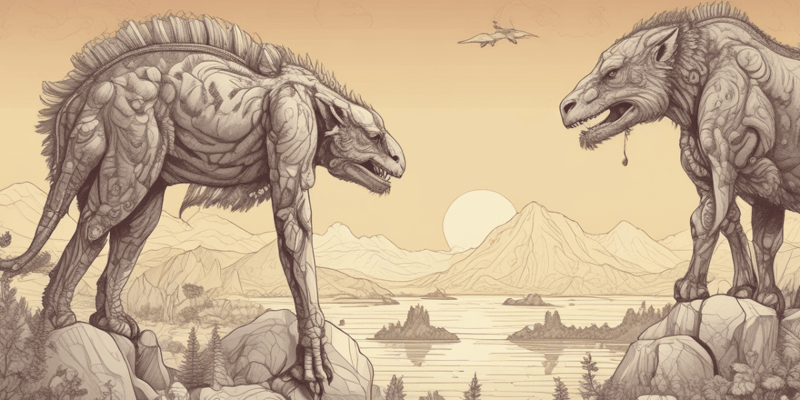Podcast Beta
Questions and Answers
What is the primary focus of the gene-centered view of evolution?
What is the term used to describe patterns of behavior and social norms that are consistent across different cultures?
According to Plomin et al. (2016), what is the significant role of genetics in individual differences?
What is the primary reason for humans' heightened attention to animals, according to New et al. (2007)?
Signup and view all the answers
What is the main idea behind the intersection of biology and social sciences, as discussed in Nettle (2018)?
Signup and view all the answers
What is the primary focus of Williams' 1966 chapter on evolution?
Signup and view all the answers
What is the term used to describe the process by which natural selection operates on individual genes?
Signup and view all the answers
What is the main idea behind the findings of Plomin et al. (2016) on behavioral genetics?
Signup and view all the answers
What is a primary function of human intelligence, according to the research?
Signup and view all the answers
What drove the development of sophisticated social cognition in human ancestors?
Signup and view all the answers
What is a potential application of this research in education?
Signup and view all the answers
What does the research suggest about human intelligence?
Signup and view all the answers
What is a key aspect of the framework offered by Cosmides et al.?
Signup and view all the answers
What can be inferred about the development of sophisticated social cognition in humans?
Signup and view all the answers
What is a potential application of this research in policy-making?
Signup and view all the answers
What is a focus of future research directions suggested by the authors?
Signup and view all the answers
What is the primary focus of evolutionary psychology in social sciences?
Signup and view all the answers
Which of the following is a finding from Sell et al. 2009 regarding human anger?
Signup and view all the answers
What is the purpose of the human anger face according to Sell et al. 2014?
Signup and view all the answers
What did Daly et al. 2001 find regarding income inequality and homicide rates?
Signup and view all the answers
What is the primary aim of Cosmides et al. 2010?
Signup and view all the answers
What is a key adaptation discussed in Cosmides et al. 2010?
Signup and view all the answers
What do evolved algorithms process according to Cosmides et al. 2010?
Signup and view all the answers
What is the significance of the cross-cultural evidence presented in Cosmides et al. 2010?
Signup and view all the answers
What is the primary function of anger according to Sell et al. 2009?
Signup and view all the answers
What is the finding regarding stepchildren in Daly & Wilson 2001?
Signup and view all the answers
What is the primary function of the human perceptual system, according to evolutionary pressures?
Signup and view all the answers
What is the effect of deprivation on learning and behavior, according to Petrinovich and Boles (1954)?
Signup and view all the answers
What is the role of maternal investment cues in shaping social behaviors, according to Sznycer et al. (2016)?
Signup and view all the answers
What is the primary function of language, according to Pinker (2003)?
Signup and view all the answers
How do biological factors influence cultural practices and transmission, according to Rogers (1988)?
Signup and view all the answers
What is the primary mechanism by which infants learn about the edibility of plants, according to Wertz and Wynn (2014)?
Signup and view all the answers
What is the primary function of cognitive specializations for social exchange, according to Cosmides et al. (2010)?
Signup and view all the answers
What is the primary factor influencing racial categorization, according to Kurzban et al. (2001)?
Signup and view all the answers
What is the primary function of evolutionary psychology, according to Tooby (2020)?
Signup and view all the answers
What is the primary reason why humans are more likely to notice spiders, according to New and German (2015)?
Signup and view all the answers
Study Notes
Evolution, Selection, and Adaptations
- Williams (1966) presented the gene-centered view of evolution, emphasizing that natural selection operates on individual genes rather than organisms or species.
- Evolutionary adaptations are best understood at the level of genes, which drive the development of traits that enhance fitness.
Biology and the Social Sciences
- Nettle (2018) identified patterns of behavior and social norms that are consistent across different cultures and can be explained through evolutionary theory.
- Cultural universals highlight the influence of biological evolution on human behavior, suggesting that certain social behaviors are deeply rooted in our evolutionary past.
- Plomin et al. (2016) highlighted ten robust findings from behavioral genetics, including the significant role of genetics in individual differences in behavior and cognitive abilities.
- Genetic factors substantially contribute to social behaviors and cultural patterns, indicating a strong biological basis for these phenomena.
Sensation and Perception
- New et al. (2007) found that humans have a heightened attention to animals compared to inanimate objects, which reflects ancestral priorities where detecting animals could be crucial for survival.
- Human perceptual systems are biased towards detecting animals, indicating that these systems were shaped by evolutionary pressures to prioritize potential threats or resources in the environment.
- New and German (2015) demonstrated that humans are more likely to notice spiders, an ancestral threat, even when attention is divided, compared to other non-threatening stimuli.
Learning
- Petrinovich and Boles (1954) found that deprivation states, such as hunger, significantly influence learning and behavior, enhancing certain responses while inhibiting others.
- Deprivation can alter learning processes and behavioral responses, demonstrating the impact of physiological states on behavior.
- Sznycer et al. (2016) showed that longer coresidence with a mother increases altruism among siblings, indicating that perceived maternal investment affects sibling relationships.
Language
- Pinker (2003) argued that language is an adaptation shaped by natural selection for specific functions in human evolution.
- Language evolved as an adaptation for complex social interactions and cognitive tasks, enhancing communication and cooperation.
Social Learning
- Rogers (1988) suggested that biological factors can limit the extent and manner in which cultural traits are adopted and transmitted.
- Culture is influenced by biological constraints, indicating an interplay between genetic and cultural evolution in shaping human behavior.
- Wertz and Wynn (2014) found that infants selectively learn about plant edibility by observing adults, suggesting an evolved mechanism for acquiring knowledge about safe foods.
Cognition
- Cosmides et al. (2010) identified cognitive specializations for social exchange and cooperation, suggesting that human intelligence evolved to handle complex social interactions.
- Human cognitive abilities are shaped by evolutionary pressures to solve social exchange problems, enhancing cooperation and social cohesion.
- Kurzban et al. (2001) found that racial categorization can be reduced when coalitional information is made salient, suggesting that race is not a primary category but a cue for group membership.
- Tooby (2020) argued that evolutionary psychology offers a coherent framework for understanding diverse social behaviors by linking them to adaptive problems.
Emotions
- Sell et al. (2009) found that anger serves as a bargaining tool in social interactions, signaling strength and deterring others from exploiting the individual.
- Anger is an evolved response to social threats, functioning to protect individuals' interests and maintain social equilibrium.
- Sell et al. (2014) showed that the human anger face enhances cues of strength, making individuals appear more formidable to others.
Social Pathology
- Daly et al. (2001) found that higher income inequality correlates with higher homicide rates in Canada and the United States, suggesting socio-economic factors influence violence.
- Socioeconomic disparities contribute to social pathologies such as violence, highlighting the impact of environmental conditions on antisocial behavior.
- Daly and Wilson (2001) found that stepchildren are more likely to suffer from neglect and abuse than biological children, consistent with evolutionary predictions of nepotism.
Studying That Suits You
Use AI to generate personalized quizzes and flashcards to suit your learning preferences.
Description
This quiz covers the concepts of evolution, natural selection, and adaptations, with a focus on the gene-centered view of evolution. It explores how evolutionary adaptations arise at the level of genes, driving the development of traits that enhance fitness.




